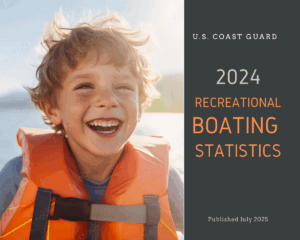By Jeff Moag, Water Sports Foundation

For nearly 20 years I’ve had a Google alert set to collect news coverage about canoeing and kayaking. As former editor of the country’s biggest paddling magazine, I sought to monitor great public interest stories, like the Minnesota man who once ran a marathon with a canoe on his shoulders.
What I found instead was a steady stream of news reports about fatal paddling accidents, rescues and close escapes. Almost invariably, the coverage contained a variation of this line in the second or third paragraph: The victim was not wearing a life jacket.
When I began working with the Water Sports Foundation, a national nonprofit that supports the U.S. Coast Guard’s safety outreach efforts, I added Google alerts for fishing, power boating and sailing. The volume of accident news immediately tripled, but one constant remained: Across every type of boating and paddling, the victims in the vast majority of fatal accidents were not wearing a life jacket.
Reporters covering boating accidents know to ask about life jackets, because the question goes to the How and Why of fatal accidents and miracle survival stories alike. But the deeper context can be harder to capture, especially on a short deadline. Statistics are a great way to give a story depth and authority. Here we’ve collected a few of the most revealing examples from the most recent U.S. Coast Guard accident data.
Key Statistics
- Drowning was the cause of death in 79 percent of fatal boating accidents where cause of death was known
- 86 percent of those drowning victims were not wearing a life jacket.
- Nationwide, those statistics translate to 439 drowning victims in 2019, at least 362 of whom were not wearing life jackets. Life jacket use was not known for 20 people.
- Nine out of 10 drownings occur on inland waters within a few hundred feet from shore, and half of recreational boating fatalities happen on calm water.
These figures are taken directly from the U.S. Coast Guard’s annual Recreational Boating Statistics (RBS) database and published report, a massive trove of information on boating accidents and their causes in the United States. I’ve highlighted key findings for you, because at 83 pages, the annual RBS Report can feel like information overload for reporters on deadline.
However, if you want to peruse the full report, I recommend a quick review of the detailed table of contents to help with navigation. In addition, the “Command-F” trick will expedite your search. For example, if you’re looking for statistics about the number of boating accidents in your state, search by state name or postal abbreviation to toggle quickly through a host of stats. This can be a powerful tool for local news coverage, such as this piece in Montana’s Great Falls Tribune. https://www.greatfallstribune.com/story/news/2020/06/22/boating-deaths-take-dip-montana-2019/3236177001/
The RBS data runs about a year behind the calendar date, and new reports are issued each summer. Access them here [https://uscgboating.org/statistics/accident_statistics.php].

Life Jacket & Boating Safety Context
- The United States Coast Guard estimates that 80 percent of drowning fatalities could have been prevented if the victim had been wearing a life jacket.
“It’s critical for boaters to wear a life jacket at all times because it very likely will save your life,” said U.S. Coast Guard Capt. Scott Johnson.
Johnson could give any number of examples, but one in particular sticks in his mind. In November 2019, an Indiana family of eight attempted to cross the White River in a 14-ft boat. The overloaded boat capsized [link: https://www.nytimes.com/2019/09/03/us/white-river-martinsville-indiana-capsized.html] and five people died, including a 6-year-old child. None of the victims was wearing a life jacket.
- Most U.S. states require children under 12 or 13 to wear life jackets on moving boats. Use this tool to research the law in your state. https://www.boatus.org/life-jacket-loaner/state-requirements/ A federal law requiring all children under the age of 13 to wear a life jacket on a boat while under way applies in states that do not have specific life jacket requirements.
- Adults must carry life jackets on their vessel for all passengers, but in most cases are not required to wear them. Some states require adults to wear life jackets while operating certain types of vessels, such as personal watercraft (Jet Skis). The Coast Guard maintains a list of state regulations here. https://www.uscgboating.org/regulations/state-boating-laws-details.php?id=25&title=%5B4.9%5DLife%20Jackets
- Only 11.9 percent of adult boaters overall, and 6.3 percent of power boaters, reported wearing life jackets in a 2017 U.S. Coast Guard study. [https://uscgboating.org/library/national-live-jacket-wear-study/2017-Life-Jacket-Wear-Rate-Observation-Study-Report.pdf]
- The fact that boaters are required to carry life jackets but not use them means almost all drowning victims had a life jacket close to hand. They simply chose not to wear it.
That hard irony has led to a push for mandatory life jacket laws. A Coast Guard advisory panel recommended in 2012 that the agency make life jacket wear mandatory on all paddlecraft and boats under 18 feet, including personal watercraft. Two factors influenced the resolution: Drowning rates are higher in small boats, and trial programs in Mississippi and Pennsylvania showed that mandatory life jacket rules reduce drownings dramatically.

In the Mississippi trial, boating fatalities dropped 57 percent in the three years after the mandatory life jacket rule took effect compared to the three years before. https://www.djournal.com/news/corps-will-still-require-life-jackets-on-lakes-for-boaters-swimmers-skiers/article_64765bba-4cc2-5594-9ad1-6b72a711d3da.html
To date, the Coast Guard has not implemented mandatory life jacket rules, preferring to promote voluntary wear through awareness campaigns in partnership with state agencies.
“There is no single more important thing you can do to improve your odds of safe boating than wear a life jacket,” said Jason Roberts, a recreation warden with the Wisconsin Department Natural Resources. “We try to get that message out as often as possible because it can really save lives.”
Evolving Life Jacket Designs and Options
One persistent consumer knock against life jackets is that they’re bulky, uncomfortable and hot. Many of us remember the orange horse-collar life jackets from summer camp. In recent years, however, a new generation of more comfortable, fashionable and effective life jackets has transformed the market.
Specialized life jackets are available for sports enthusiasts, such as form-fitting vests for wake boarders and water skiers. Life jackets designed for advanced whitewater kayakers are made with integrated rescue harnesses, while kayak anglers can now buy purpose-built flotation devices with pockets for fishing tackle and tools.
The biggest advance for most boaters has been lightweight self-inflating life jackets. These are particularly popular among active anglers and other boaters who value comfort and unrestricted movement. These unobtrusive life-saving devices can be worn on the hottest days. It the wearer goes overboard, the life jacket inflates automatically.
Whatever the style of jacket chosen for today’s boating activity, it is important to ensure proper fit and function.
A Matter of Style and Media Support
A quick note on style: the U.S. Coast Guard prefers the term life jacket (two words) over Personal Flotation Device (PFD). The AP and Chicago Stylebook have yet to weigh in on the subject, but most of us in the marine industry space prefer life jacket versus PFD, as life jacket best describes what this vital piece of safety equipment actually does: it saves lives.
Our job as reporters is to remain objective and to get the facts right. To this end, the communications team at the Water Sports Foundation has designed the National Boating Safety Media Center to provide relevant and accurate content, imagery, experts and resources to assist journalists in story development. If further assistance is needed, please feel free to Contact Us for additional support. https://www.watersportsfoundation.com/about/contact-us/
Supplemental Life Jacket Information
The U.S. Coast Guard’s life jacket resource page
https://uscgboating.org/recreational-boaters/life-jacket-wear-wearing-your-life-jacket.php
Life Jacket Rules and Penalties by State (USCG Chart)
Life Jacket Requirements by State (interactive map)
https://www.boatus.org/life-jacket-loaner/state-requirements/
The Sea Tow Foundation maintains a life jacket loaner program
https://www.boatus.org/life-jacket-loaner/
How to clean and maintain your life jacket during Covid-19
###
ADDITIONAL MEDIA SUPPORT
The communications team at the Water Sports Foundation has designed the National Boating Safety Media Center to provide relevant and accurate content, imagery, experts and resources to assist journalists in story development. If further assistance is needed, please feel free to Contact Us for additional support. https://www.watersportsfoundation.com/about/contact-us/



